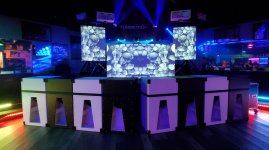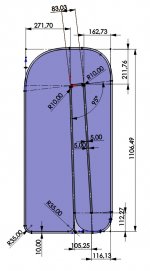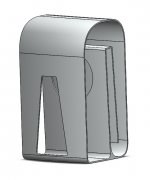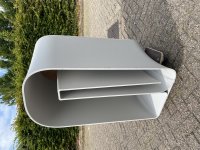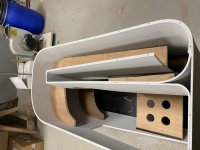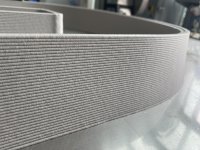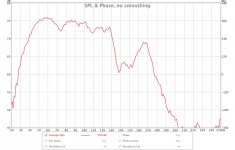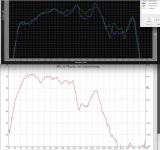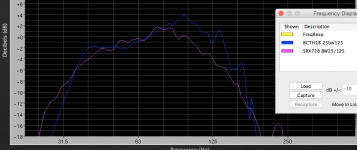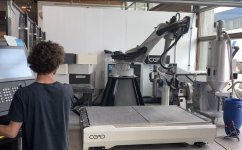I simmed a ton of cheaper driver options and no winners. Stick to Art's suggestions if you plan to build one or the MFR designs of the drivers you have.
that doesn't surprise me - Arts design is very impressive and if you follow his design to the "T" and that includes the use of the B&C 18SW115, you'll have a "winner" ...
I'm glad I went with the 18SW115s for my build as they are really worth the outlay

Cheers
Martin
Here's some pictures of the 2 setups this weekend. The 8 stack was only running on 1 20A circuit so we couldn't get into it too much. Even so, the police came to say hi after around a dozen noise complaints from neighbors over a half mile away. Kinda crazy for taking place at one of the biggest live music venues in the city. They were very nice and even complimented the sound.
The setup with 6 I had 3 20A circuits which allowed me to run all out, and simply put, it was devastating. It felt as if the building itself was breathing, utterly insane.
Nice setup 😳 I've tried both my two keystones either standing up or laying by their sides, they play considerably better standing up imo. Try to listen for differences, just a tip.
That's interesting Osse. I wonder if it's because you're running 2, because I measured them both standing up and on their sides and the response was similar. Objectively the sound from the 8 stack on their sides sounded slightly less evenly spread throughout the venue but I attributed that to each stack of 4 being separated. I haven't yet measured 8 on there sides all in one stack but I'll do that next time I have them all out.
Hello again, sounds unlikely to me, as two cabs will have very little effect on each other, they have no cancellations or such things between each other like with more cabs so one or two should be ideal to determine the best orientation of cabs, isn't that so? I've heard it at least one other time, subwoofers playing considerably better stacked in one orientation than the other (with only one each side). I guess it has to do with port or exit orientation and which exit will load closer to the ground and such, but I have only listened and not measured so in the end I really don't know.
Hi guys. I'm curious if there is any info out there on bass arrays with tapped horns? This past weekend I was running my 8 keystones all in a row with each group of 4 angled slightly outward. I had to do this because the stage was round but regardless, there was a very noticeable beaming effect happening. If you stepped just off to the side of the subs the bass dropped significantly. This got me wondering if anyone had experience trying out end-fire arrays or arc arrays with tapped horns. I've been reading through Rog Mogale's paper on bass arrays but I wasn't sure if that data is relevant to tapped horns or not. Any insight would be appreciated!
Attachments
As far as arrays, there is nothing different about tapped horns or front loaded horns compared to bass reflex or sealed enclosures, other than their individual size, shape, and directivity. The upper bass range (above 60Hz) of TH and FLH generally has more directivity than direct radiators with similar frontal dimensions.Hi guys. I'm curious if there is any info out there on bass arrays with tapped horns? I've been reading through Rog Mogale's paper on bass arrays but I wasn't sure if that data is relevant to tapped horns or not. Any insight would be appreciated!
Like the Keystone sub, the upper response of many TH and FLH is not axisymmetric, so there is some degree of difference that will be noticed depending on cabinet orientation.
The Keystone sub has very similar frequency and phase response to the DSL TH-118, and is similar in size, if you would like to model various arrays, you could do so using the TH-118 in the Danley Direct modeling software:
NEW DANLEY DIRECT FREE MODELING SOFTWARE | Danley Sound Labs, Inc.
for Mac or Windows:
Danley Digital Tools | Danley Sound Labs, Inc.
Danley Direct modeling software is accurate for the direct field, but does not factor in boundary reflections or room modes, so your small room results will not be the same as predicted.
Art
Last edited:
3d printed Keystone
Hi all! We’re excited to share our adventure. First I want to thank Art Welter for sharing his ideas here on this forum, as well as the others who have contributed to this thread.
Our question is: what value can be had to 3d print speakers?
We evaluated the original Keystone design and modified it to make it more suitable to print. Some figures:
- similar internal volume (344L without woofer)
- similar width, length and expansion rate of the horn fold, except for the
corners.
- made a concave surface to increase stiffness of the print surface
- printed with recycled PETG and 30% fibreglass. Quite a bit stiffer than plywood.
- wall thickness of 14mm and a final weight of around 70 kg
- braced with multiplex
- B&C 18SW115 4 Ohm woofer
- printed with a CEAD extruder
Hi all! We’re excited to share our adventure. First I want to thank Art Welter for sharing his ideas here on this forum, as well as the others who have contributed to this thread.
Our question is: what value can be had to 3d print speakers?
We evaluated the original Keystone design and modified it to make it more suitable to print. Some figures:
- similar internal volume (344L without woofer)
- similar width, length and expansion rate of the horn fold, except for the
corners.
- made a concave surface to increase stiffness of the print surface
- printed with recycled PETG and 30% fibreglass. Quite a bit stiffer than plywood.
- wall thickness of 14mm and a final weight of around 70 kg
- braced with multiplex
- B&C 18SW115 4 Ohm woofer
- printed with a CEAD extruder
Attachments
3d printed Keystone - results
We took the occasion of a day with no rain (those are rare in Holland) to get some measurements in. Please ignore the absolute SPL scale.
The groundplane measurements are taken in (quite) windy conditions on 10m distance, input is unequalized.
What do you think of the dip of 3-4 db around 73 Hz? Do you think there is a way to alter the design to prevent this phenomenon?
We are quite excited with how it sounds when we took it for a spin on two venues. I can't compare it with the original keystone though, someone in Holland who is keen to compare two sibblings?
Considering the possibilities 3d printing on this size presents, what do you all think we should print next?
-Piet
We took the occasion of a day with no rain (those are rare in Holland) to get some measurements in. Please ignore the absolute SPL scale.
The groundplane measurements are taken in (quite) windy conditions on 10m distance, input is unequalized.
What do you think of the dip of 3-4 db around 73 Hz? Do you think there is a way to alter the design to prevent this phenomenon?
We are quite excited with how it sounds when we took it for a spin on two venues. I can't compare it with the original keystone though, someone in Holland who is keen to compare two sibblings?
Considering the possibilities 3d printing on this size presents, what do you all think we should print next?
-Piet
Attachments
Hi Speetpeet.
That is a very intreresting construction.
The 3d printed part looks very simple, almost a 2D extrusion apart from the Keystone shape. Is this a limitation of the 3d printing process used or could more complicated geometry be printed?
One advantage of most 3D printing processes is that shapes that would be almost impossible to create by any other method can be acheived.😉.
It would be great to really go wild with full size horn geometry free from the limitations of current construction techniques....
That is a very intreresting construction.
The 3d printed part looks very simple, almost a 2D extrusion apart from the Keystone shape. Is this a limitation of the 3d printing process used or could more complicated geometry be printed?
One advantage of most 3D printing processes is that shapes that would be almost impossible to create by any other method can be acheived.😉.
It would be great to really go wild with full size horn geometry free from the limitations of current construction techniques....
Piet,What do you think of the dip of 3-4 db around 73 Hz? Do you think there is a way to alter the design to prevent this phenomenon?
We are quite excited with how it sounds when we took it for a spin on two venues. I can't compare it with the original keystone though, someone in Holland who is keen to compare two sibblings?
Considering the possibilities 3d printing on this size presents, what do you all think we should print next?
3d MEH (multiple entrant horns) come to mind as a good use of the large scale printing!
The response of your 3d printed Keystone looks very different from the original.
The original has a lower flat “step” from a bit below 40 to 60Hz, then increasing in level about 5dB around 100 Hz, with a few higher peaks at around 135 and 165Hz, and a last peak at around 225Hz similar to the LF level.
Your 3d response also appears to have a gap between 135 and 165Hz, dropping steeply after, with an overall downward trend after 60Hz. It is possible the reduced cabinet volume from rounding the corners has reduced the LF below 50 Hz, while the split path bracing reduced the upper response. That said, without knowing the sensitivity, can’t be sure if yours has more bottom, or less top than the original Keystone.
The original Keystone matches the dual 18” 4 ohm JBL SRX728 sensitivity and response shape fairly closely. If you could find one of those to test under similar conditions, you could determine “what’s what”.
Art
Attachments
Last edited:
Is this a limitation of the 3d printing process used or could more complicated geometry be printed?
As long as the next layer rests on the previous layer, you can make it as complex as you like without a production penalty. The maximum "overhang" of the next layer is around 45 degrees. That means you're not limited to 'extrusion' type shapes. We're considering to print ridges laterally and vertically on all the surfaces, to make bracing redundant.
Material could be another interesting factor to play with as well. PIPG is fairly cheap and recyclable, however, one could also opt for stiffer / heavier composites if your willing to pay extra. For large volume prints this might not that interesting, but for smaller ones definitely.
We'll keep you posted on developments.
A MEH type speaker was indeed the next print on the planning. Seems like a great match!
Attachments
Piet,
It is possible the reduced cabinet volume from rounding the corners has reduced the LF below 50 Hz, while the split path bracing reduced the upper response.
Art
The response looks different indeed. We've compensated the reduction of volume of the rounded corners with adding width to the cabinet. The internal volume should be identical to the original Keystone. Thank you for the notion of the split path bracing.
That said, without knowing the sensitivity, can’t be sure if yours has more bottom, or less top than the original Keystone.
The original Keystone matches the dual 18” 4 ohm JBL SRX728 sensitivity and response shape fairly closely. If you could find one of those to test under similar conditions, you could determine “what’s what”.
Art
Next test we'll try to measure it's sensitivity. We're curious.
There should be some dual 18” 4 ohm JBL SRX728 floating around here somewhere. I'll see if I can find any.
- Home
- Loudspeakers
- Subwoofers
- Keystone Sub Using 18, 15, & 12 Inch Speakers
